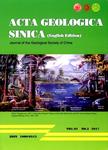Late Triassic Granites From the Quxu Batholith Shedding a New Light on the Evolution of the Gangdese Belt in Southern Tibet
Late Triassic Granites From the Quxu Batholith Shedding a New Light on the Evolution of the Gangdese Belt in Southern Tibet作者机构:College of Earth Science and Engineering Shandong University of Science and Technology Qingdao 266590 Shandong China Key Laboratory of Depositional Mineralization and Sedimentary Mineral of Shandong province Qingdao 266599 Shandong China Qingdao Institute of Marine Geology China Geological Survey Qingdao 266061 China Institute of Geology Chinese Academy of Geological Sciences Beijing 100037 China School of Earth Sciences andEngineering Nanjing University Nanjing 210023 China
出 版 物:《Acta Geologica Sinica(English Edition)》 (地质学报(英文版))
年 卷 期:2018年第92卷第2期
页 面:462-481页
核心收录:
学科分类:070903[理学-古生物学与地层学(含:古人类学)] 0709[理学-地质学] 0819[工学-矿业工程] 07[理学] 08[工学] 0818[工学-地质资源与地质工程] 0708[理学-地球物理学] 081402[工学-结构工程] 0816[工学-测绘科学与技术] 0814[工学-土木工程]
基 金:supported by the China Postdoctoral Science Foundation(M2017612220) the Shandong Province Natural Science Foundation(Doctoral Funds,ZR2017BD033)
主 题:Late Triassic Neo-Tethys Ocean active continental margin Gangdese batholith southern Tibet
摘 要:The Gangdese magmatic belt formed during Late Triassic to Neogene in the southernmost Lhasa terrane of the Tibetan plateau. It is interpreted as a major component of a continental margin related to the northward subduction of the Neo-Tethys oceanic slab beneath Eurasia and it is the key in understanding the tectonic framework of southern Tibet prior to the India-Eurasia collision. It is widely accepted that northward subduction of the Neo-Tethys oceanic crust formed the Gangdese magmatic belt, but the occurrence of Late Triassic magmatism and the detailed tectonic evolution of southern Tibet are still debated. This work presents new zircon U-Pb-Hf isotope data and whole-rock geochemical compositions of a mylonitic granite pluton in the central Gangdese belt, southern Tibet. Zircon U-Pb dating from two representative samples yields consistent ages of 225.3~=1.8 Ma and 229.9~1.5 Ma, respectively, indicating that the granite pluton was formed during the early phase of Late Triassic instead of Early Eocene (47-52 Ma) as previously suggested. Geochemically, the mylonitic granite pluton has a sub-alkaline composition and low-medium K calc-alkaline affinities and it can be defined as an I-type granite with metaluminous features (A/CNK〈I.1). The analyzed samples are characterized by strong enrichments of LREE and pronounced depletions of Nb, Ta and Ti, suggesting that the granite was generated in an island-arc setting. However, the use of tectonic discrimination diagrams indicates a continental arc setting. Zircon Lu-Hf isotopes indicate that the granite has highly positive till(t) values ranging from +13.91 to +15.54 (mean value +14.79), reflecting the input of depleted mantle material during its magmatic evolution, consistent with Mg# numbers. Additionally, the studied samples also reveal relatively young Hf two-stage model ages ranging from 238 Ma to 342 Ma (mean value 292 Ma), suggesting that the pluton was derived from partial melting of juvenile crust. Geochemical dis



